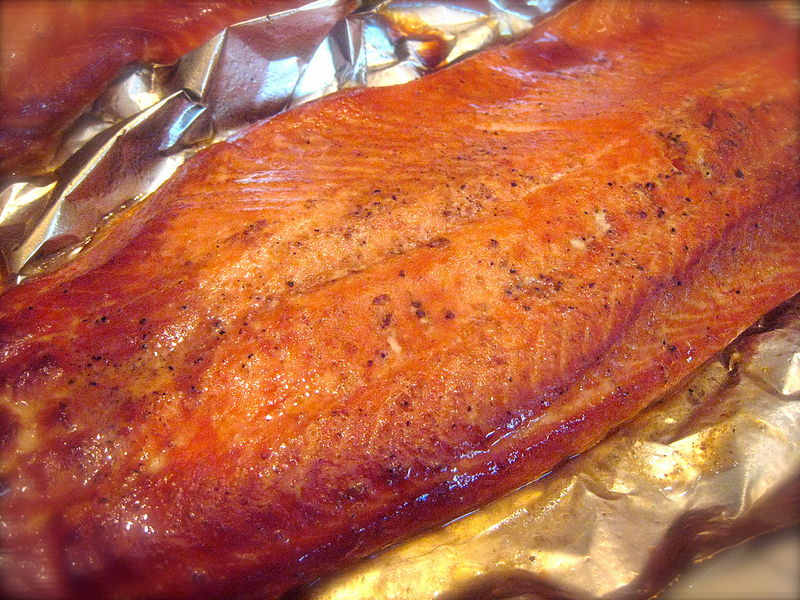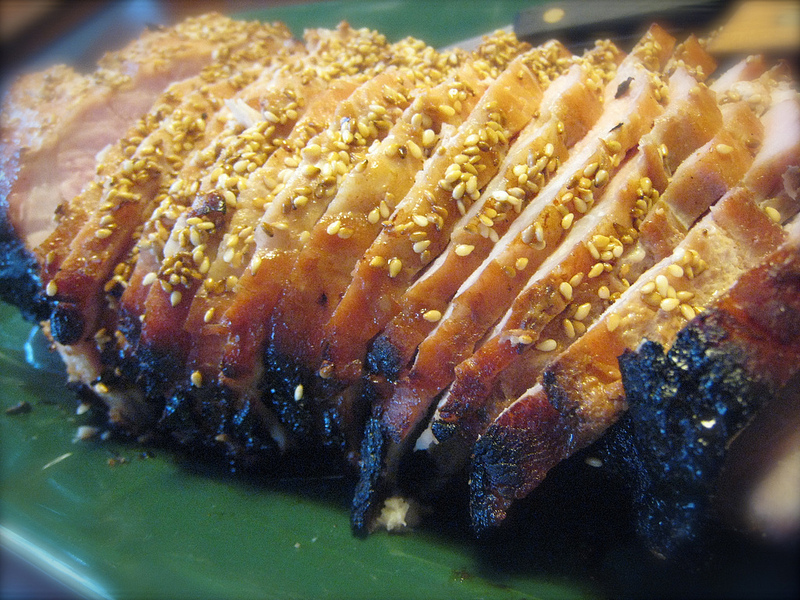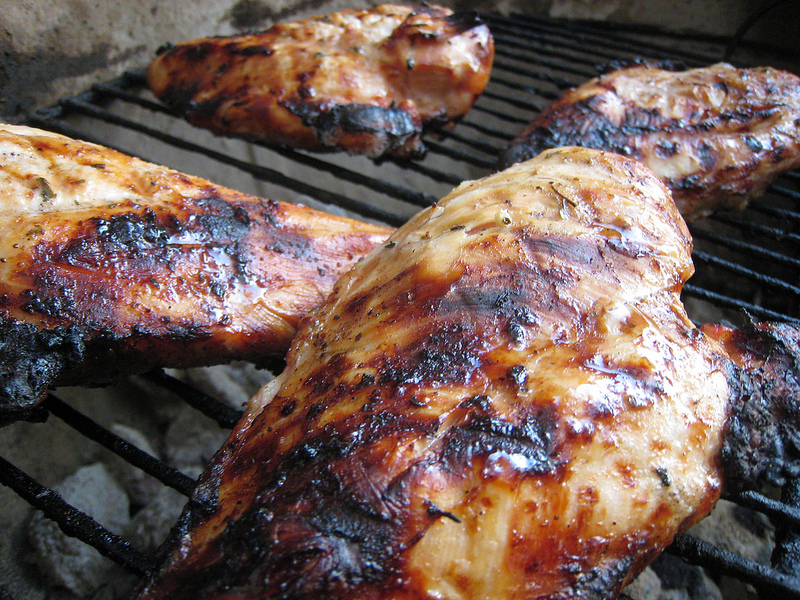
I’m not sure whence came the recipe for this one, although I suspect that it was one of Jamie Purviance’s books for Weber.
In any case, Alder Wood for salmon is one of my favorite smoke pairings.

I’m not sure whence came the recipe for this one, although I suspect that it was one of Jamie Purviance’s books for Weber.
In any case, Alder Wood for salmon is one of my favorite smoke pairings.

My Mother-In-Law had brought me a nice pork loin awhile back for cooking on the rotisserie, and this past week we decided to get it out of the deep freeze and cook it for Sunday dinner. I began researching recipes and ran across several for Char Siu, which is a Chinese pork barbecue. The literal translation is “fork roast” meaning roasted on a skewer. This sounded like just what I was after.
After a little refined searching, I found Trader Vic’s recipe for the dish. Although obviously Americanized (the marinade includes ketchup), it seemed easy enough to prepare with ingredients that were readily available to me, and recipes from Vic’s have always pleased my palate in the past.
The loin was about 5 3/4 pounds, so the first problem that presented itself was that I didn’t have anything large enough to marinate it in. I had seen in one of my reference books (Weber’s Way To Grill) that you can tie two pieces of loin together with butcher’s twine to make a properly sized roast for the rotisserie, so I cut the pork in half, removed much of the fat cap, and placed it in a gallon ziplock bag with equal parts ketchup, sugar, Soy Sauce and Hoisin (about half a cup of each). It marinated in the refrigerator overnight.
About an hour before cooking, I removed it from the fridge, trussed it together with the fat toward the outside and put it on the skewer, taking care to get the tines into both pieces of the roast. I cooked it over indirect high heat on the Weber Kettle with some Hickory chips on the charcoal.

After about 50 minutes, it was getting close to 140 degrees (my target temperature was 140-150). At this point I removed it from the rotisserie, cut off the twine, and placed it fat side down in a 9×13 pan on the gas grill over indirect medium-high heat (about 450). I kept a close eye on the probe thermometer, and when the internal temperature of the meat topped 140, I removed it and brought it in to rest at room temperature. I toasted some sesame seeds and sprinkled them over the top of the roasts as a finishing touch.
We served this with mustard and sweet/sour sauce as condiments, with awesome garlic mashed potatoes and sweet corn that my wife had prepared as side dishes. She said later that it was the best pork she’d ever tasted in her life.
The flavor was quite a bit more subdued than I had anticipated. It was just sweet enough and just savory enough, with none of the strong flavors in the marinade overpowering the dish. The meat was perfectly done, juicy and tender. This is definitely a recipe that I’ll make time and again.

This is an incredibly simple recipe that turns out delicious, succulent chicken.
1) Soak chicken pieces in fresh lemon juice for half-an-hour or so.
2) Blot the chicken dry and marinate overnight in plain yogurt.
3) Wipe off the chicken, season lightly with salt and pepper, grill until done.
That’s it.

In preparation for this year’s Thanksgiving Dinner, I roasted a whole turkey on the rotisserie over the weekend. In some ways, this is one of the most challenging things to cook, since it’s difficult to get the dark meat done enough without overcooking the breast.
Overall, it turned out just “alright.” Having done a marvelous job with a turkey breast awhile back, and a series of awesome whole chickens, I expected this to be over-the-top delicious. It certainly wasn’t bad, especially for a first attempt, but there are several things I would do differently next time.
1) Use a fresh turkey. The frozen turkey I cooked was “pre-basted.” This sounds like it would be a good thing, but it’s actually not. The addition of a brine solution prior to freezing actually changes the texture and taste of the bird in a way that is inferior to proper dry brining. For Thanksgiving, I’ll look for a locally raised fresh turkey.
2) Take more care with the seasoning and brining. Because the turkey was pre-basted, I didn’t want to overdo my own seasoning, particularly the salt. I limited my efforts to a little kosher salt, black pepper and herbs de provence rubbed on the skin a couple hours prior to roasting. I also didn’t stuff the cavity, thinking that this was a “dry run” anyway, and the additional aromatics wouldn’t add much. Next time, I’ll take care to properly dry brine a fresh turkey the day before, and to add plenty of citrus, onions, garlic, etc. to the cavity before cooking. My wife usually works some olive oil under the skin just prior to putting the bird in the oven as well. Although the rotisserie helps to keep food moist through self-basting, we may try her trick as well.
3) Choose your smoke wisely. I’ve been on a Cherry wood kick lately, loving the subtly sweet flavor it added to pork ribs and beef roast. In the case of turkey, I think a bolder smoke flavor would have been nice. I’ll likely use Apple, Hickory, or a mixture of the two next time.
4) I need an ice pack. One of the tricks Mike Vrobel suggests when roasting turkey on the rotisserie is to put an ice pack on the breast while it comes to room temperature before going on the grill. This has the effect of increasing the cooking time for the white meat, and allowing the legs and thighs to get up to well done without overcooking the breast. It’s listed as an “optional” step in his instructions, but I’ll definitely use it next time. The breast turned out alright, but the dark meat could have cooked just a bit longer to achieve “fall off the bone” tenderness.
A friend of mine sensed my disappointment in describing the meal as “alright” and commented that every meal doesn’t have to be a masterpiece. I suppose that’s right, although as much time and effort as goes into this particular dish, I’ll want to get it perfect next time. I think the adjustments mentioned above will make it worthy of our Thanksgiving table.
For Christmas of 2012, my wife gave me a rotisserie attachment for my Weber Kettle Grill. I’d wanted one for a long time, though the $150 price tag seemed a little too extravagant. The notion of roasting food on a spit, like the honeymoon scene in It’s A Wonderful Life, has always seemed romantic to me, and once the rotisserie arrived I could hardly wait to fire up the coals and roast something amazing with it. There was one problem. I had absolutely no idea how to cook with it.
I mean, of course I knew that the spit goes through what you’re cooking and you turn the motor on and it spins – but I didn’t know anything else about the process or preparing food for the rotisserie, how to set up the grill, how long to cook things, etc.
Luckily, in addition to a book on rotisserie cooking that was also under our tree for me, I did a little online search and found Mike Vrobel’s book Rotisserie Grilling and his site, Dad Cooks Dinner. I’ve come to think of Mike as the authoritative source on the subject, and his are among the first resources I turn to when I am researching something I haven’t cooked before. His dry-brined rotisserie chicken was the very first thing I cooked on my kettle rotisserie, and it’s still one of my favorite dishes.
One of the next things I tried was a turkey breast, and it was so delicious that my wife decided I should be responsible for our Thanksgiving turkey this year. Since a whole turkey involves a lot of special setup and variables, we figured it would require a test run, so that’s what I’m doing this coming Sunday.
Vrobel’s step-by-step advice on the matter will obviously be the game plan for the day, beginning with his demonstration of how to truss and spit the bird. Since I’ve had good luck with chickens and with the turkey breast, I’m expecting the whole turkey to be wonderful, but there is one further thing I have to learn between now and Sunday – how to carve.
I know. One might expect that at 56 years of age a guy would know how to carve a turkey, but through the years we always seemed to travel to someone else’s home for Thanksgiving dinner, and over the last decade or so, my wife’s father was always with us to carve. Honestly, I’ve been a bit timid in the face of the pressure. So I never learned. In fact, even for more pedestrian fare, I tend to shove off the carving duties onto my wife. Lack of confidence is an awful thing.
Finally I am determined to do it despite my insecurities, and (thankfully) I ran across this video from the New York Times a few years ago, and happened to have logged the URL. They make it look simple.
Wish me luck!
Copyright © 2025 Noebie Digital Media · Powered by WordPress and the Genesis Framework